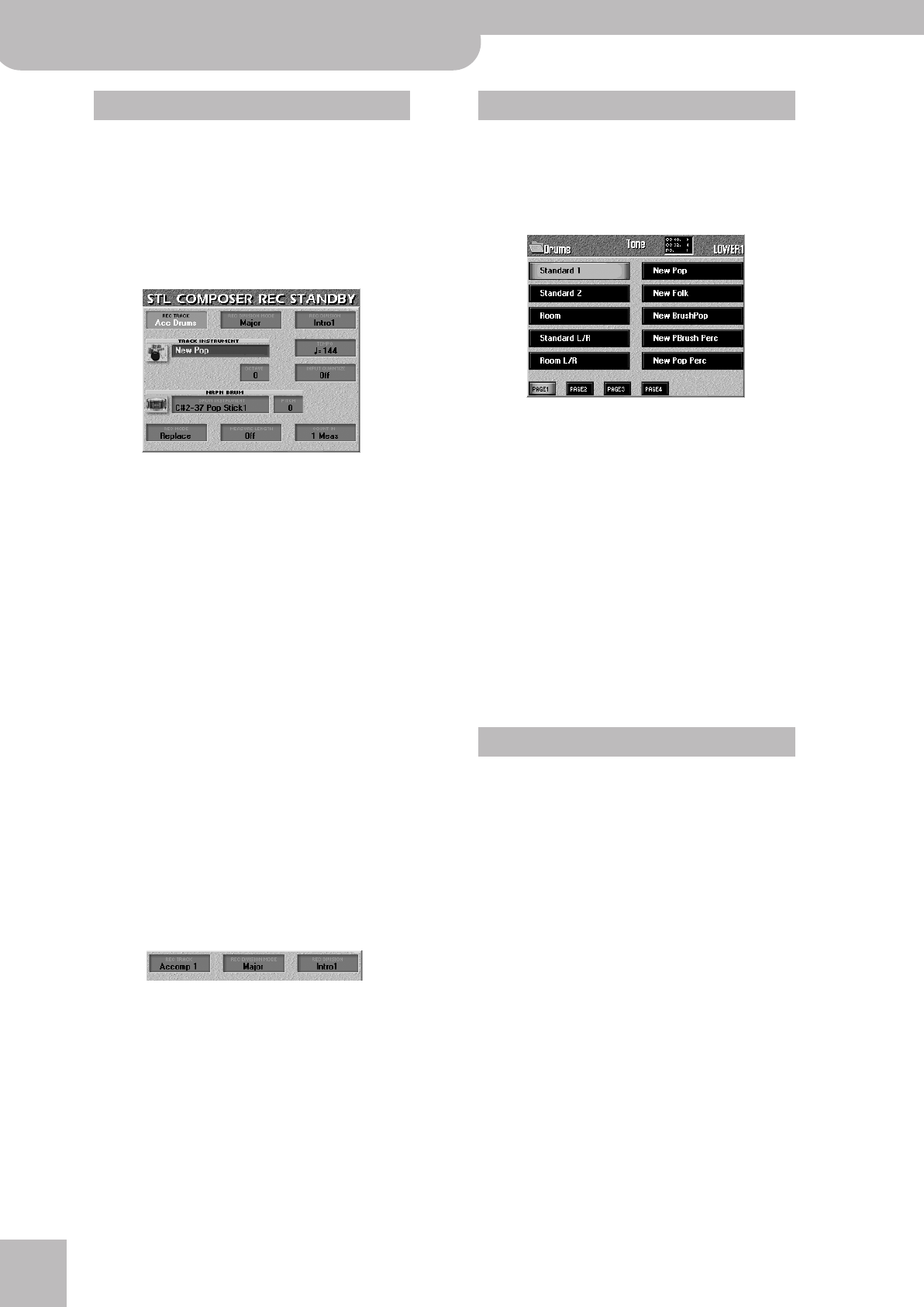
Programming Styles (Style Composer)
154
r
E-60/E-50 Music Workstation
To keep things easy, let’s start with the drums of the
MAIN [1] Division.
(9) Press the [REC¥TRACK] field and use the
[DATA÷ENTRY] dial to select the track you wish to
record to.
Select “AccDrums”. This causes the display to change
as follows (because there are more options for drum
tracks):
Now select a pattern. Let’s start with MAIN [1]:
(10) Press the [REC¥DIVISION] field and use the
[DATA÷ENTRY] dial to select “Main 1”.
■Working with clones
On this page, you can use two clone functions that
allow you to record one part and copy it to up to four
Divisions and three Modes each. The “=” sign means
that more than one pattern will be recorded.
(11) Use the [REC¥DIVISION¥MODE] field to select the
mode(s).
This parameter allows you to specify whether you are
about to record the accompaniment for major, minor
or seventh chords. If you listen to the Styles prepared
by Roland, you will notice that there are slight differ-
ences in the looped patterns – and sometimes strik-
ing differences for Intros and Endings, with com-
pletely different phrases. Such variations can be pre-
pared using the REC DIVISION MODE parameter.
Let us use the following settings, which mean “record
the major pattern and copy it to all MAIN Divisions”.
Thus, with one recording, you will obtain 3 (Major,
minor, 7th) x 4 (MAIN 1, 2, 3, 4)= 12 identical drum
patterns!
Another important aspect is sound selection because
the addresses of the sounds and Drum Set you select
are recorded at the beginning of each division.
(12) Press the [TRACK¥INSTRUMENT] field and select a
Drum Set.
• Press a TONE button on the front panel and press the
field of the desired sound. If you don’t like it, press
another field.
• If you are still not happy with the Tone, use the
[PAGE¥1]~[PAGE¥4] and [˚] fields to select the corre-
sponding page (if available).
Note: The AccDrums track can only use Drum Sets (so that
only the [DRUMS] button of the TONE pad is available).
Play a few notes on the keyboard to check whether
the sounds of the selected Drum Set are suitable for
the accompaniment you are going to record. Try
other Drum Sets until you find the one that sounds
“right”.
Note: See “Drum Instrument & Pitch” on p. 161 for details
abut the NRPN DRUM and PITCH parameters. These are only
available for ADrum tracks.
If you want to use the accompaniment in a musically
meaningful way, you need to tell the E-60/E-50 what
key you are recording in. This is to ensure that the
chords you play during everyday use of your Style
with the E-60/E-50’s Arranger lead to the correct
realtime transpositions of the selected Division.
The E-60/E-50 allows you to record Styles in any key.
But do set the KEY parameter to the right value
before recording.
Note: The key of AccDrums parts cannot be set (because that
doesn’t make sense).
(13) Press the [KEY] field and use the [DATA÷ENTRY] dial
or the [DEC]/[INC] buttons to set the key.
If you want to record in F#, set this parameter to “F#”;
to record in A, you must set this value to “A”, etc.
■Octave
The field next to [KEY] allows you to transpose the
keyboard in octave steps, which may be convenient
for extremely high or low notes – or for using the
special “noises” of certain sounds.
(14) Press the [OCTAVE] field and use the [DATA÷ENTRY]
dial to transpose the keyboard up or down (–4~+4
octaves).
Selecting the track, the Mode and the Division Tone selection
Specifying the key (for melodic parts)
E-60_50_OM_UK.book Page 154 Thursday, June 22, 2006 10:06 AM
